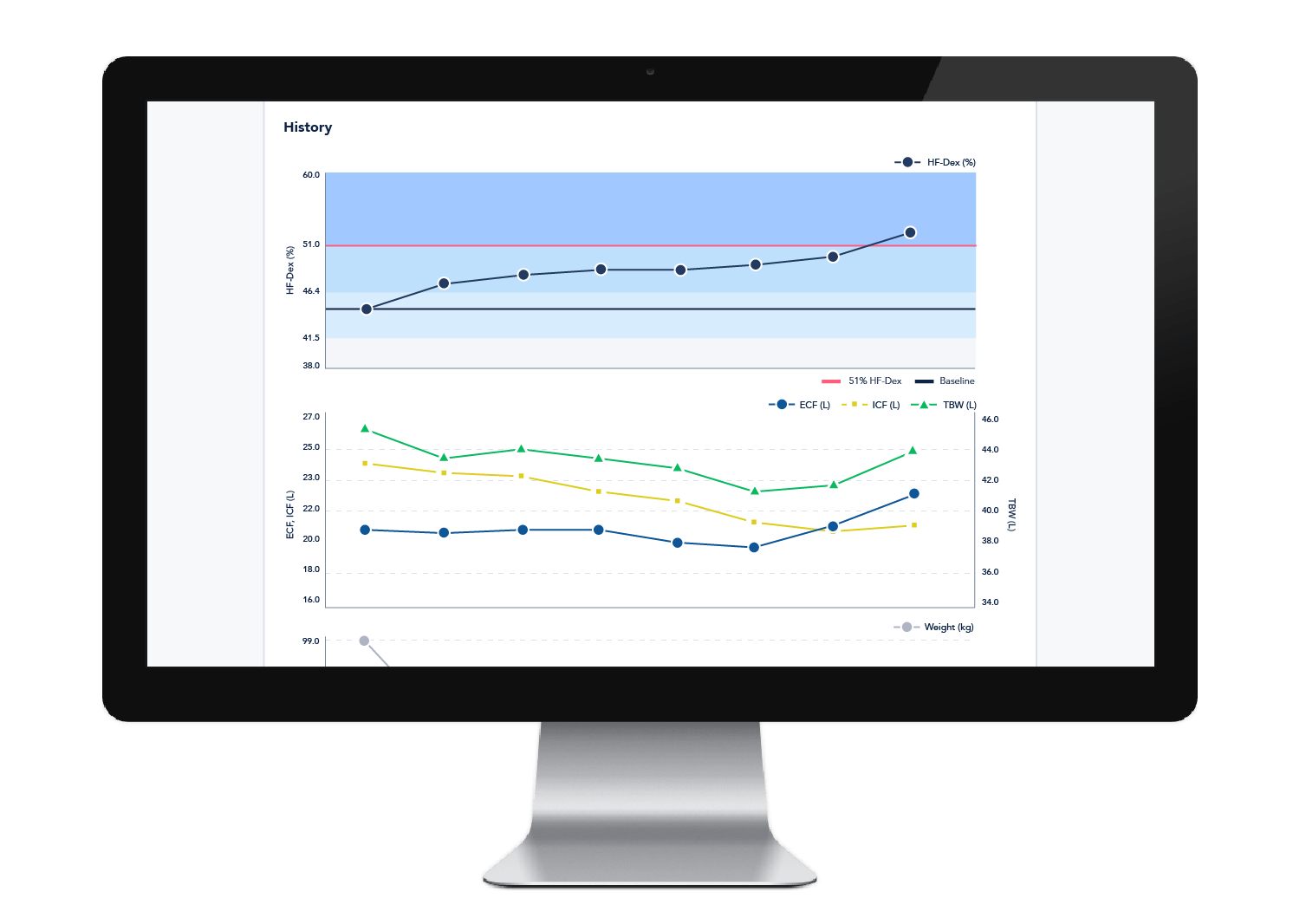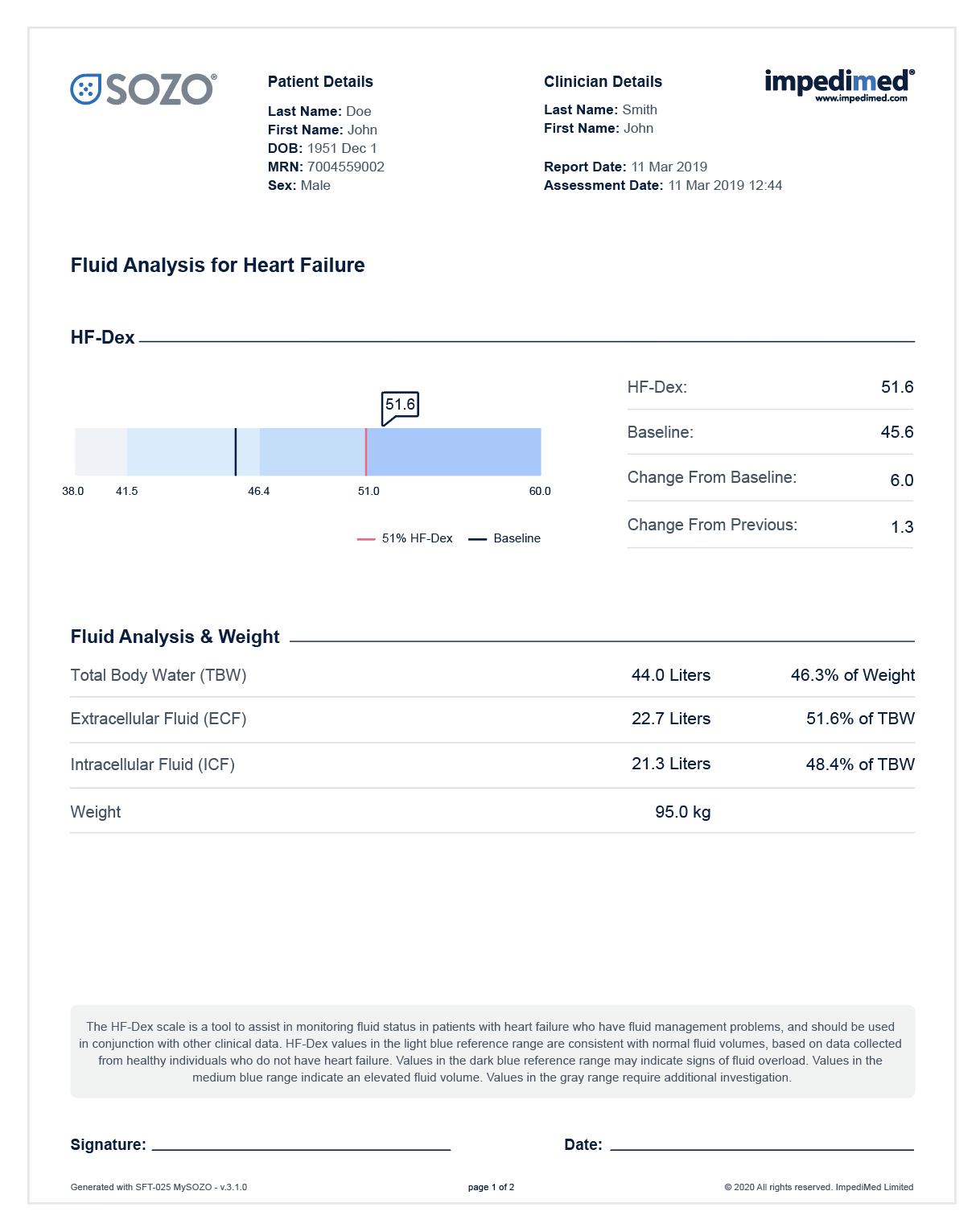More Sensitive than Weight Alone
Differentiates between fluid and tissue-related weight changes.
Heart failure (HF), also known as congestive heart failure or chronic heart failure (CHF), affects ~26 million people globally. Current monitoring technologies such as weight scales or implantable pulmonary artery pressure (PAP) monitors are either inaccurate or require invasive procedures. SOZO offers a fast, accurate, and non-invasive measurement of fluid burden to better monitor and manage heart failure patients.
Our goal is to improve quality of life and reduce readmissions of heart failure patients.

The SOZO Digital Health Platform uses bioimpedance spectroscopy (BIS), an advanced application of bioimpedance technology, to objectively measure fluid volume in the human body. When applied to a heart failure patient population, SOZO offers new insight into patient fluid status to help clinicians monitor and manage their patients.

Reducing hospital admissions is a key quality metric for managing heart failure patients. Heart failure affects approximately 26 million people worldwide1. Once hospitalized, up to 25% of heart failure patients are readmitted within 30 days2,3. Fluid management with the use of diuretics is a cornerstone of heart failure therapy, yet adequate diuresis is not quantified as a quality measure4. To better monitor and manage heart failure patients, an accurate and objective measure of body fluid is needed.

ImpediMed’s sophisticated BIS technology ensures high quality, objective fluid volume measurements, every time.
Download Sample Report
Reduced cardiac function in heart failure patients leads to a buildup of extracellular fluid. The extent of volume overload leading to decompensation, and symptoms that drive hospitalization, can vary from patient to patient and change with disease progression.

The HF-Dex heart failure index provides a consistent metric for tracking fluid volumes and changes due to impaired cardiac function or medication. A HF-Dex over 51% is a marker for potential future hospital readmission in heart failure patients.
Contact us to learn more about SOZO with HF-Dex and the benefits of implementing an objective measure of fluid volume for your heart failure patients.
1. Savarese, G. and L.H. Lund, Global Public Health Burden of Heart Failure. Card Fail Rev, 2017. 3(1): p. 7-11.
2. Dharmarajan, K., et al., Diagnoses and timing of 30-day readmissions after hospitalization for heart failure, acute myocardial infarction, or pneumonia. JAMA 2013. 309(4): p. 355-63.
3. Desai, A.S. and L.W. Stevenson, Rehospitalization for heart failure: predict or prevent? Circulation, 2012. 126(4): p. 501-6.
4. Peled H. Letter to the editor: readmissions and diuretic dosing. JACC Heart Failure 2017;5(8)618 9.
5. Serra-Prat M, et al. Intracellular Water Content in Lean Mass is Associated with Muscle Strength, Functional Capacity, and Frailty in Community-Dwelling Elderly Individuals. A Cross-Sectional Study. Nutrients 2019;doi:10.3390/nu11030661.
6. Serra-Prat M, et al. Intracellular Water Content in Lean Mass is Associated with Muscle Strength, Functional Capacity, and Frailty in Community-Dwelling Elderly Individuals. A Cross-Sectional Study. Nutrients 2019;doi:10.3390/nu11030661.
7. Serra-Prat M, et al. Total Body Water and Intracellular Water Relationships With Muscle Strength, Frailty and Functional Performance in an Elderly Population. J Nutr Health Aging . 2019;23(1):96-101.
8. Capillary Fluid Exchange: Regulation, Functions, and Pathology. Scallan J, Huxley VH, Korthuis RJ. San Rafael (CA): Morgan & Claypool Life Sciences; 2010.
9. Kimura G, et al. A simulation study on transcellular fluid shifts induced by hemodialysis. Kidney International. 1983;24:542-8.